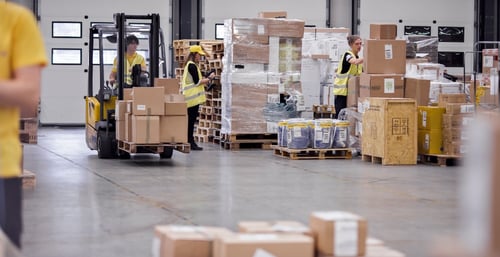Nov 10, 2020 9:09:32 AM
Training & learning | Operations | Employee engagement
Nov 10, 2020 9:09:32 AM
Training & learning | Operations | Employee engagement

Frontline employees make up the vast majority of the workforce globally. In this brief guide we'll cover frontline employees - who they are, how their needs differ from their desk-based peers, and why they need a digital workplace to be at their best.
Table of Contents
1. Who are Frontline Employees?
2. Frontline Workers vs. Remote Workers
3. Where Do Frontline Employees Work?
4. The Size of the Frontline Workforce, and the Industries They Work in
5. The Challenges Frontline Employees Face
6. What is a Digital Workplace, and Why do Frontline Employees Need One?
7. Why Invest in a Digital Workplace for Frontline Employees?
--
A frontline employee hands you your morning latte.
A frontline employee comes to do your gas safety inspection every year.
And it's a frontline employee who boxes up your packages for delivery when all the stores are closed.
Frontline employees do just about everything, but this phrase is a broad one.
What does it actually mean?
Any employee who doesn't spend the majority of the working day behind a desk.
Sounds obvious, right?
A few other names frontline employees go by are:
Frontline employees don't have access to a company computer like their office-based peers. Most don't even have a company email address.
Remote workers might spend some or all of their time away from the office, but most are still desk-based. Remote workers usually have a company computer and email address as well as a dedicated workspace, whether that workspace is at home or somewhere else away from the office. Remote workers typically have access and regularly use the same workplace tools as office-based employees.
Frontline employees spend most of their time on their feet or traveling between sites. They rarely have a company computer that they take with them, and they don't have a dedicated workspace with access to the same tools used by office-based employees.
Here's a list of some of the most common places you can find frontline employees:

There are 2.7 billion frontline employees globally, making up 80% of the workforce.
Here's a breakdown of the top industries employing frontline workers:
Frontline employees manufacture and deliver the products we consume every day.
Frontline employees build and maintain the infrastructure of cities and roads.
Frontline employees also keep stores and restaurants stocked and running.
These are just a few of hundreds of possible examples.
Whatever industry they work in, frontline employees are essential to the existence of the organizations employing them.
But unfortunately, many industries employing frontline workers have some of the highest levels of turnover and lowest levels of engagement out there.
By focusing on the frontline employee experience, employers can start to truly value everyone who isn't at the office 9-5.
And because of the work frontline workers do, this will have a profound impact on a company's profitability and growth.
Desk-based employees have a physical workplace where they can connect and collaborate with peers.
On top of that, desk-based workers typically have a stack of digital tools to increase engagement, improve training and make them more efficient at everything they do.
Frontline employees don't have the same physical arena for collaborating with peers.
On top of that, they've been underserved by the tech industry, so most haven't been enabled with the same stack of digital tools as their office-based peers.
Frontline employees need a digital workplace.
Most of the challenges they face stem from this reality.
Here are 3 of them.
Office workers who see each other every day have more communication and engagement tools than most frontline employees.
This leads to frontline employees feeling disconnected and out of the loop from the rest of the company.
Ultimately, this impacts their performance. It's been proven time and time again that engaged employees do better work.
A study by Gallup found that manufacturing organizations with engaged employees outperform those with unengaged employees by 202%.

Spending on corporate training in 2019 totalled $83 billion in the United States alone.
And last year, almost half of training hours were delivered by an instructor in a classroom setting.
Even in the corporate world, classroom-based training is still the norm. But this style of training isn't the right fit for frontline employees.
Some frontline employees are your customers' first point of contact with your brand.
Some frontline employees have highly specialized and technical knowledge that keeps factories, warehouses and construction sites running safely and efficiently.
Standard onboarding practices just don't cut it for employees with such a vast array of job responsibilities, all of which are central to business continuity.
Frontline employees are rarely sitting at a desk. And their training needs to keep up.

Efficiency and productivity are the name of the game for a big chunk of frontline employees who work in manufacturing, transportation and even retail and hospitality.
Products need to be manufactured and delivered as quickly and perfectly as possible. Customers need to be served better and faster, every day.
But despite how many corporate tools have been developed to help desk-based workers manage their time, manage their projects and digitize paper-based procedures to maximize accuracy, these haven't crossed over into the deskless world.
Many processes used by frontline employees every day are still done manually or even on paper.
This slows them down, makes errors more likely, and prevents them from going above and beyond.
And ultimately, it's a subliminal signal to frontline workers that the organization under-values their contributions.
That's bad news for retaining and attracting a workforce of dedicated, engaged employees.

Let's jump back to the digital workplace we mentioned earlier, and how not having one is the source of the road blocks frontline workers run into that prevent them from doing and feeling their best at work.
It's the digital equivalent of the physical workplace office workers have, designed to support employee collaboration, productivity and continually improving performance.
The digital workplace is the entire concept, and it's supported by tools and tech and the organization uses to make this happen.
According to Deloitte's Digital Workplace Report, "The digital workplace encompasses all the technologies people use to get work done in today's workplace - both the ones in operation and the ones yet to be implemented."
By investing in tech that supports your frontline staff's digital workplace, you're giving frontline employees a space to connect and collaborate with their peers and overcome the disconnect many feel.
A digital workplace helps organizations overcome all the challenges mentioned above - low engagement, insufficient training and outdated processes.
But overall, by investing in a digital workplace for your frontline workforce, you're doing these 3 very important things:
--
Improving the overlooked, undervalued employee experience of frontline employees isn't just about buying a few innovative new tech platforms and calling it a day.
It requires a mindset shift and willingness to listen to all employees, wherever they are. And it's high time for every company to get started.
YOOBIC's all-in-one digital workplace platform for frontline employees helps them perform their best through streamlined processes, seamless communication and continuous learning.
Search the blog

See why 350+ businesses are using YOOBIC
YOOBIC creates a better everyday working experience for frontline teams while helping businesses drive performance at scale.
PRODUCT
See why 350+ businesses are using YOOBIC
YOOBIC creates a better everyday working experience for frontline teams while helping businesses drive performance at scale.